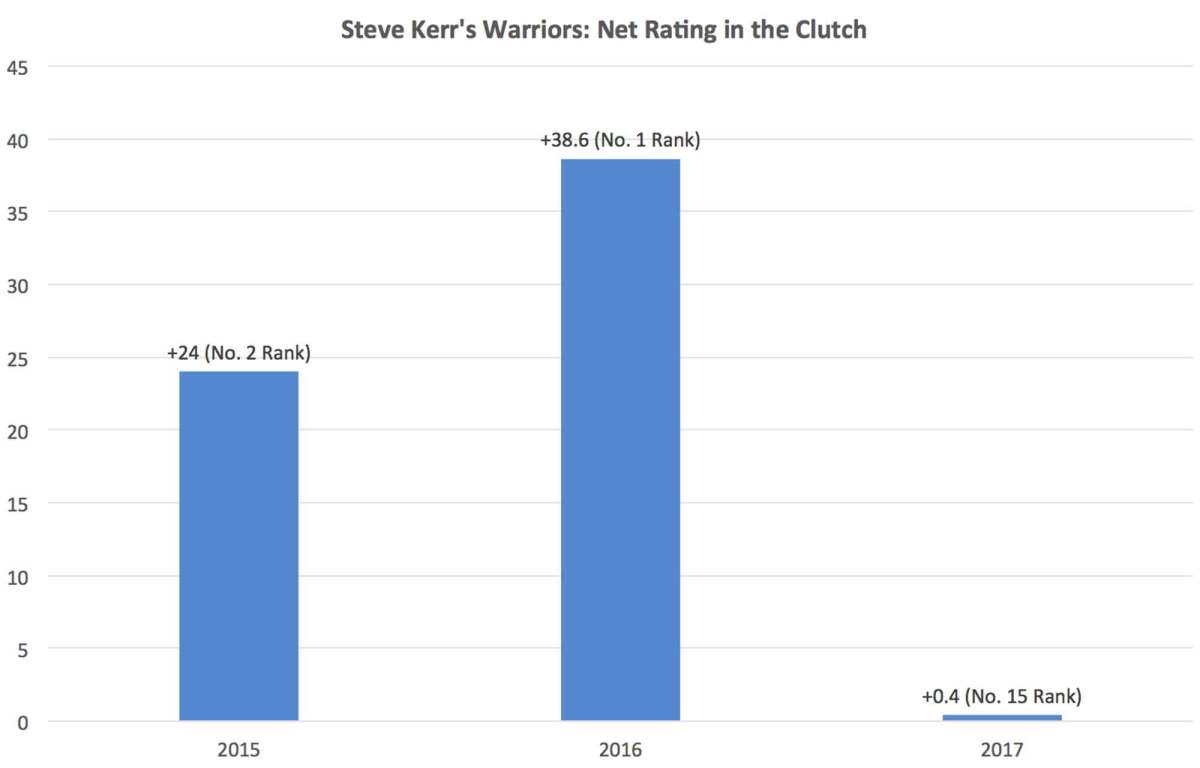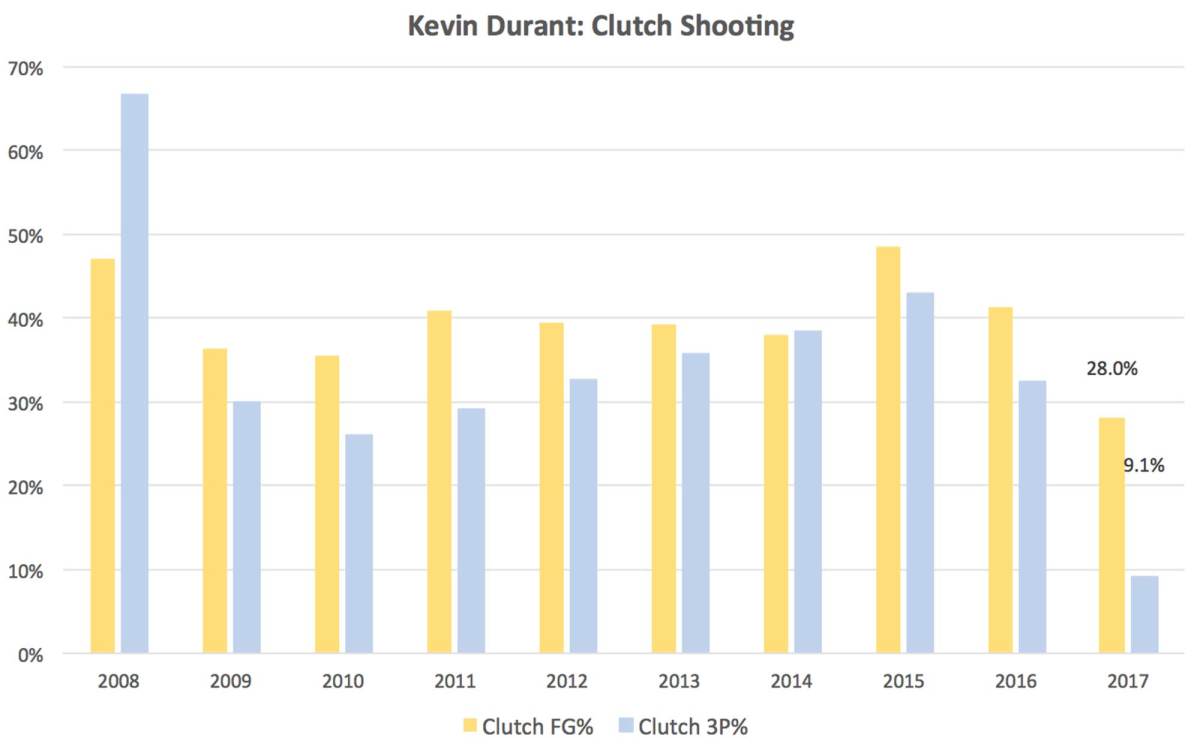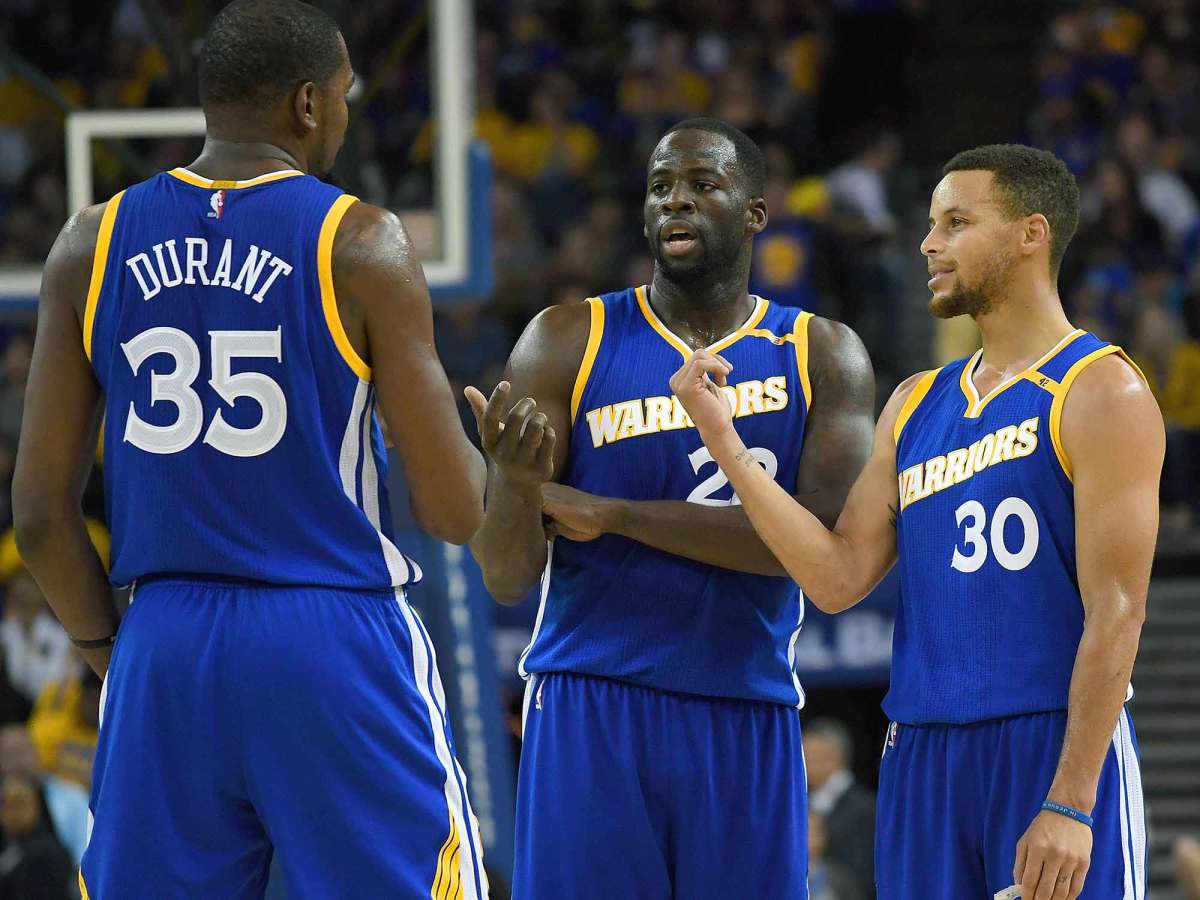The Warriors' Custody Dispute Over The Ball

Deep into a fourth-quarter collapse against the Grizzlies last month, forward Kevin Durant and point guard Stephen Curry engaged in the type of tug-of-war that enlivens superteam skeptics and fuels alpha-dog debates. For a few seconds, the Warriors’ two gracious MVPs, each accustomed to having a game’s fate in his hands, simply couldn’t decide who should get the basketball on the penultimate play of regulation, with Golden State’s 24-point lead whittled to two. Once Curry relented, Durant’s choice was a second-guesser’s dream: He dribbled down the clock, ignored his teammates and launched a contested three-pointer that missed, allowing Memphis to complete its comeback in overtime. But before critics on social media and talk radio could rev up their engines to bash Durant’s for settling and dissect Curry’s dispirited body language, Draymond Green beat them to the punch.
Sensing the unsatisfying ending before it happened, Green went from pumping his fist angrily to stalking to the corner to resting his palms on his knees rather than chase the rebound. During an ensuing timeout, Green confronted Durant with loud instructions and waving arms, pleading for a pick-and-roll attack with Curry instead of a 24-foot chuck. “I’m kind of thrilled that we lost,” Green told reporters later, noting that the Warriors needed to fix their “atrocious” fourth-quarter offense. “This is good for us.”
This scene marked the first true flashpoint for the Durant-infused Dubs, who have raced to the league’s best record with blasé brilliance. After winning 73 games last year, Golden State was “only” on a 70-win pace through Sunday, a small but critical difference that has helped cool the hype that engulfed the organization during the heights of Currymania.
Refocused and reloaded after losing to the Cavaliers in the Finals, Golden State is pursuing its revenge as patiently as possible. Durant has undertaken self-improvement projects, expending more energy on defense and patching up his relationship with the media. Curry, his load lightened, has kept busy with an assortment of pregame diversions, like pretending to spike volleyballs and sweep curling stones. Meanwhile, the Oracle crowd, conditioned to expect nightly masterpieces, has also paced itself, greeting 45-point blowouts with only modest applause.
The custody dispute over the ball and Green’s unapologetic response doubly disturbed the peace, resurrecting questions on a pair of sore subjects. Can the Warriors finish games? Can they keep their composure?
Last season Golden State’s go-to five at crunch time, a small ball unit that maximized offensive spacing without sacrificing interior defense, came to be known as the Death Lineup. The Warriors were 30–4 in games that were within five points in the last five minutes of regulation and overtime, the NBA’s best clutch record in 20 seasons. But they faltered badly in Game 7 against Cleveland, scoring just 13 fourth-quarter points, none in the final four minutes.
While Durant has enjoyed a smooth acclimation overall since leaving the Thunder to team up with Curry & Co., his presence complicates the late-game issues—as does his past. In Oklahoma City, Durant was the face of the franchise and the primary crunch-time steward. In each of his final six healthy seasons with the Thunder, Durant ranked in the top five in field goals attempts during clutch situations. At the same time the Thunder ranked no better than 25th in assist percentage in the clutch. Oklahoma City’s offense, for better and worse, relied on Durant and All-Star point guard Russell Westbrook going to work one-on-one. That approach, which produced one Finals appearance and no titles, has continued this season, with Westbrook now flying solo; at week’s end he had taken a league-high 116 shots in the clutch, nearly twice as many as any other player.
If DeMarcus Cousins Stays In Sacramento, Who Wins?
Under coach Steve Kerr, Golden State has taken a radically different view, prioritizing ball movement and spacing in pursuit of higher-percentage looks. Fresh off leading the league in assists in each of the past two seasons, the Warriors are handing out 31.2 per game, just a fraction behind the 1985 Lakers’ alltime record. Last year, that philosophical commitment to the pass held up in late-game scenarios and paid off in major ways. Even though Curry or shooting guard Klay Thompson could launch a three-pointer at any given moment, the Dubs made use of Green’s passing to keep defenses guessing and deployed auxiliary shooters like Harrison Barnes and Andre Iguodala in the corners.
Opposing defenses were constantly forced to pick between various poisons. Should they trap Curry? Should they dare Green to shoot? Should they rotate away from Thompson to stop Green from attacking down the middle? Should they risk leaving Iguodala or Barnes to guard against a Curry drive? No one cracked the code during the regular season: The 2016 Warriors posted a magnificent +38.3 net rating in the clutch, the second-best mark in 20 years.
This season, Golden State is 9–3 in games that were within five points in the final five minutes. While the Cavs are the only team with a better clutch record, the Warriors haven’t been nearly as dominant as last season when it comes to closing time. In addition to blowing the lead at Oracle to Memphis, Golden State coughed up a 14-point lead in the fourth quarter on Christmas Day in Cleveland. The new Death Lineup, with Durant in place of Barnes (who signed with the Mavericks), has yet to slay; Golden State has a mediocre +0.4 clutch net rating. “We’re not used to these fourth-quarter struggles,” Kerr admitted. “It feels weird.”

Part of this clutch drop-off can be attributed to sample size: Golden State’s total of 12 close games is easily the league’s fewest. Still, key moments during the losses to the Cavaliers and Grizzlies are instructive. In Cleveland, the Warriors tried to force-feed Durant on their final two possessions. On the first, KD failed to shake free from 6’7” Richard Jefferson, leading to indecision and a shot clock violation. Then, on the final play of regulation, Durant was blanketed by Jefferson and fell to the court before he could launch a quality shot. That excruciating defeat, which featured another Kyrie Irving game-winner, left Green so upset that he cut short his postgame media availability.
Against Memphis, the Warriors didn’t have an assist in the fourth quarter, and the final two plays of regulation produced Durant’s missed three and a forced prayer from Curry that wasn’t close. In both games Thompson got completely lost in the shuffle, making just one fourth-quarter basket against Cleveland and going scoreless in the fourth against Memphis before hitting one jumper in overtime.
Whether or not one endorses Green’s antics and blunt talk in the loss to Memphis—Kerr brushed it off as “typical teammate interaction”—the All-NBA forward was at least angry for the right reasons. The Warriors, so accustomed to being one step ahead of the defense and exploiting gobs of space, have often abandoned their ball movement and boxed themselves into corners.
On Durant’s missed three, for example, there was no secondary threat: Thompson and Iguodala stood like mannequins, Curry did his best to get out of the way, and a disgusted Green took himself out of the action. Together, they looked like a souped-up version of Durant’s old Thunder teams, forsaking the strength of the whole to let one of the parts go it alone. “[Thompson] is one of our most dangerous weapons and yet in the fourth quarter he’s not even a weapon,” Green said. ”If he’s just standing there, he’s doing us no good. That’s something we have to understand as guys who are handling the basketball.”
This is a lesson that Durant, who marveled at the Warriors’ “different way” of playing during the preseason, has yet to fully grasp. Through Sunday he was shooting just 7-of-25 (28.0%) overall and 1-of-11 (9.1%) from deep in the clutch, both career lows. He’s also had just one assist in 46 minutes of clutch time.

Even if Durant’s shooting numbers return to their usual standard, Golden State’s closing offense won’t truly take off until everyone is involved. Last year Iguodala took one shot for every 4.9 minutes he played in the clutch, delivering a number of knockout threes along the way. This year, he’s taken one clutch shot—total. Green’s involvement as a late-game scoring option has also trended downward, while Curry and Thompson are shooting worse from beyond the arc in the clutch this season compared to last. On occasion, the Warriors will recognize their stagnancy or shooting struggles and overcompensate with risky decisions that lead to turnovers.
Giannis Antetokounmpo: The Most Intriguing Point Guard In NBA History
Durant needs only to review the tape of his clutch baskets this season to find evidence that he should further embrace the Golden State way. Against the Hawks, Iguodala set up Durant for an easy lay-in and Green found him with a backdoor pass for a dunk. During overtime against the Rockets, Thompson fed him for a slam on a three-on-two break. Against the Suns, Durant got a clean mid-range look on a well-designed inbounds play and converted on a backdoor lob. Against Detroit he stepped in to a wide open catch-and-shoot three. In all, six of Durant’s seven clutch baskets have been assisted, and all six were very favorable scoring opportunities. (The seventh was a putback.)
If such positive reinforcement isn’t enough, Green can be counted on to attack the topic from the other side. Midway through Kobe Bryant’s farewell tour last year, the Lakers’ star told reporters that Green, as Golden State’s vocal leader, was responsible for “creating that conflict, that tension in the locker room” that’s necessary to stave off complacency. Despite his Finals suspension for his shot to the groin of LeBron James and an off-season assault arrest following a fight at a restaurant, Green returned this season louder than ever.
To his credit, Durant has responded to Green’s crticism with an open mind, even though his decision-making and style were never questioned so publicly by his teammates in Oklahoma City. “[Green] came and talked to me,” Durant said, downplaying the exchange against Memphis. “He always talks to me. I didn’t take it personally that he was using a loud tone. It wasn’t a disagreement or a fight. He was voicing how he felt the game should have been going and I agreed with him.”

Green’s message got through. If he could redo the possession, Durant told reporters, he would have run the pick-and-roll with Curry. He then proceeded to tick off all the possible positive outcomes that could have resulted from the two-man approach. Curry’s screen could have created a driving lane for Durant to “put some pressure on the rim.” Curry could have popped free for a cleaner look on the perimeter. The action could have drawn a double team onto Durant, creating an opportunity for a quick pass to Curry that could have “moved the defense” and freed up a shooter. “I had a matchup I liked,” said Durant, who was being guarded by Zach Randolph. “But I should have let Steph set the screen. That’s on me. We’ll get better from it. No hard feelings. None of that stuff.”
In typical Warriors fashion, order was restored quickly. Golden State rebounded from the Grizzlies loss by running off three straight double-digit wins over sub-.500 teams. But after last year’s heartbreak and this year’s occasional stumbles, the Warriors realize that beating up on weaker foes won’t be enough. Not when the Cavaliers, who are cruising along at the top of the Eastern Conference, boast the league’s best clutch offense. “There are some things we need to correct to win a championship,” Green acknowledged.
The critical correction is easy to identify but harder to implement. Durant must resist the matchups he likes in favor of the ones Golden State loves.
